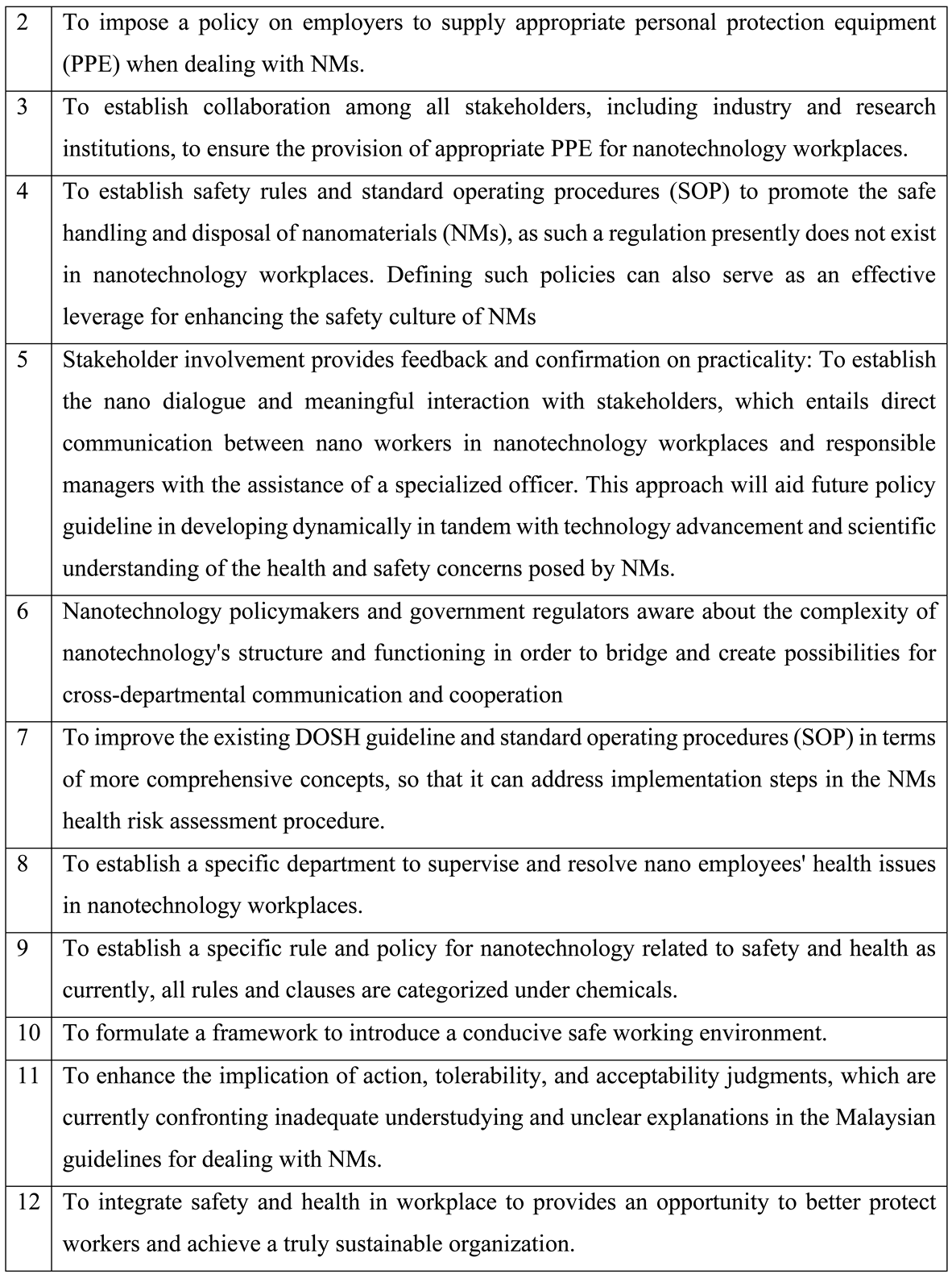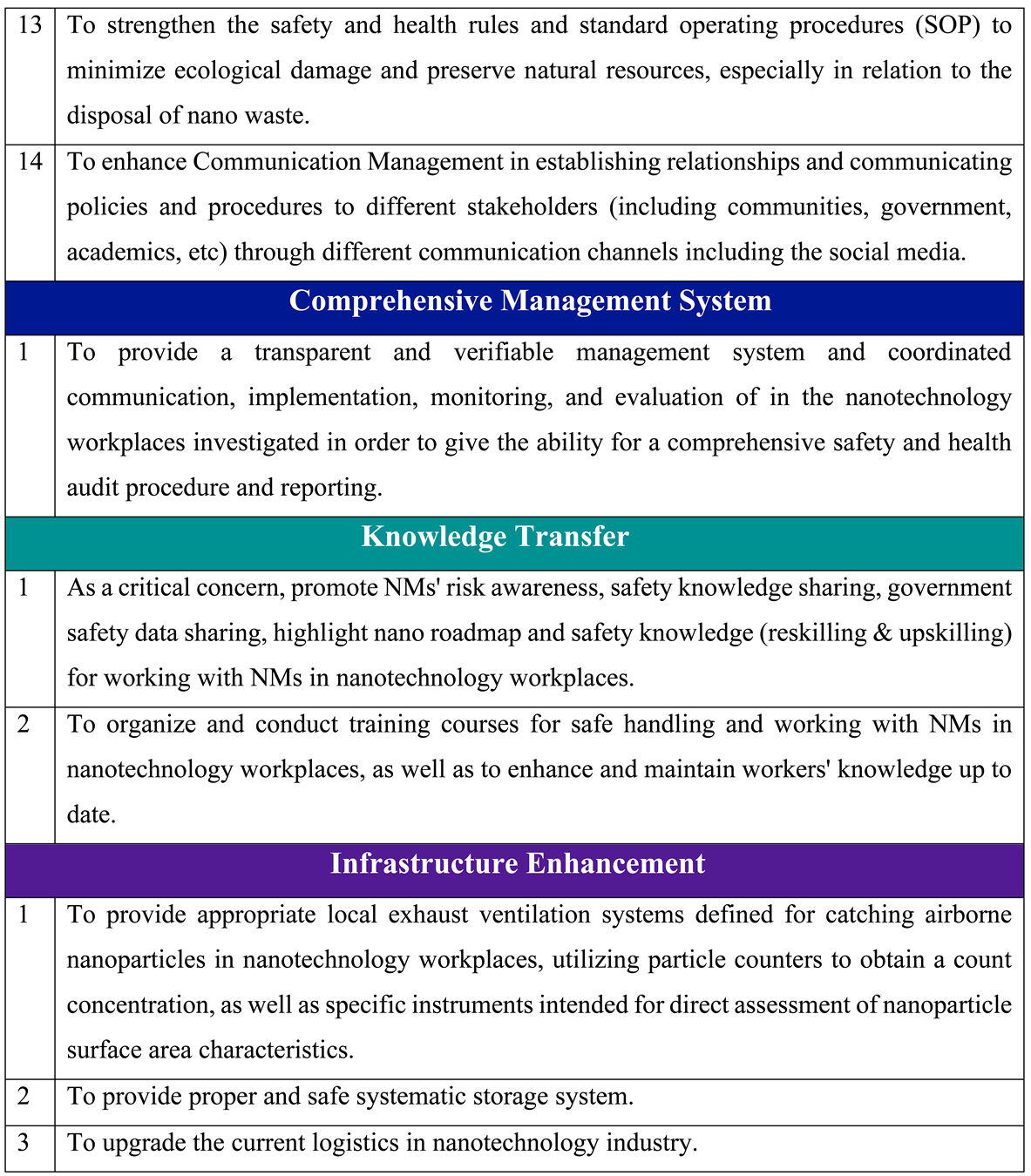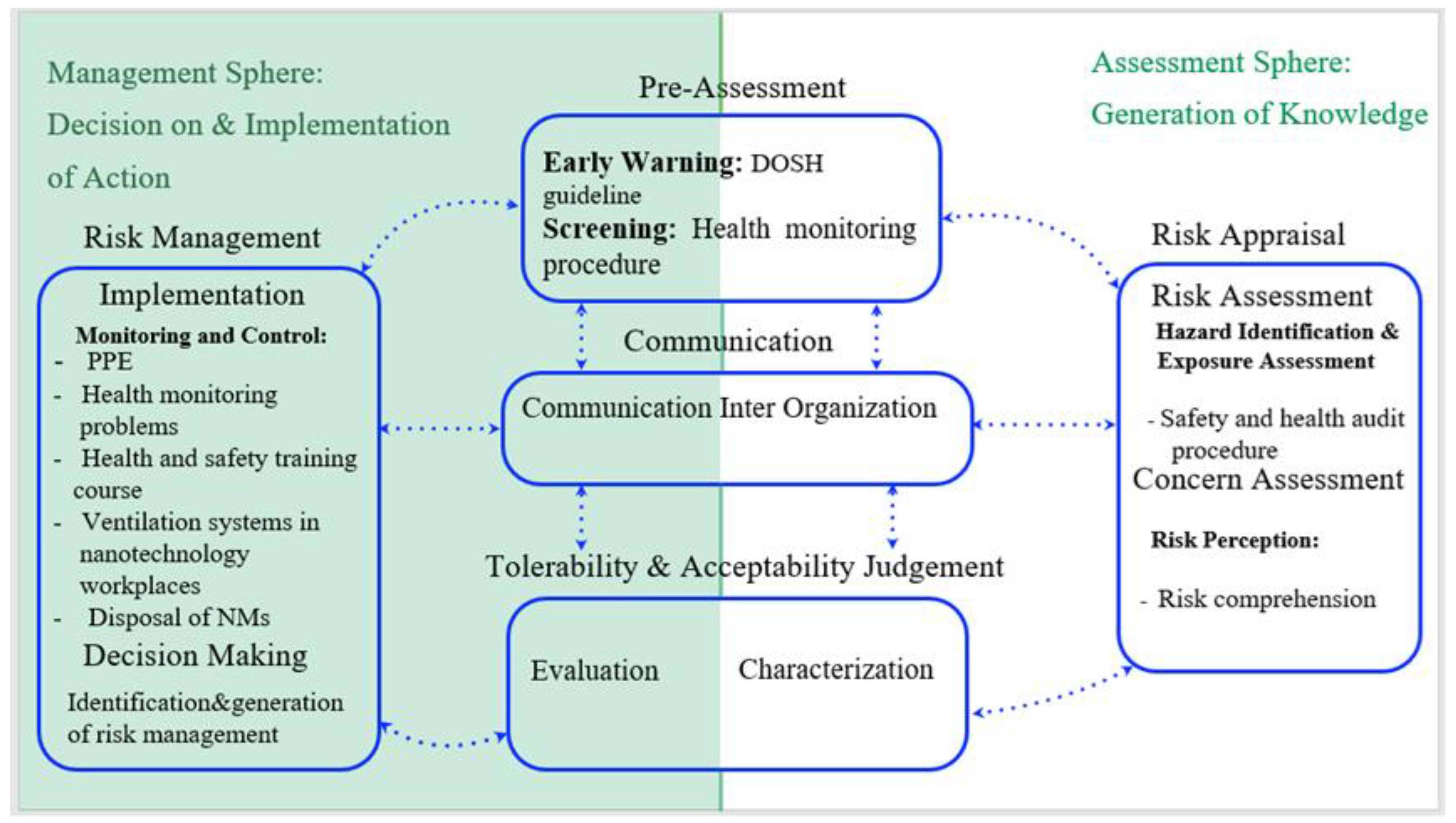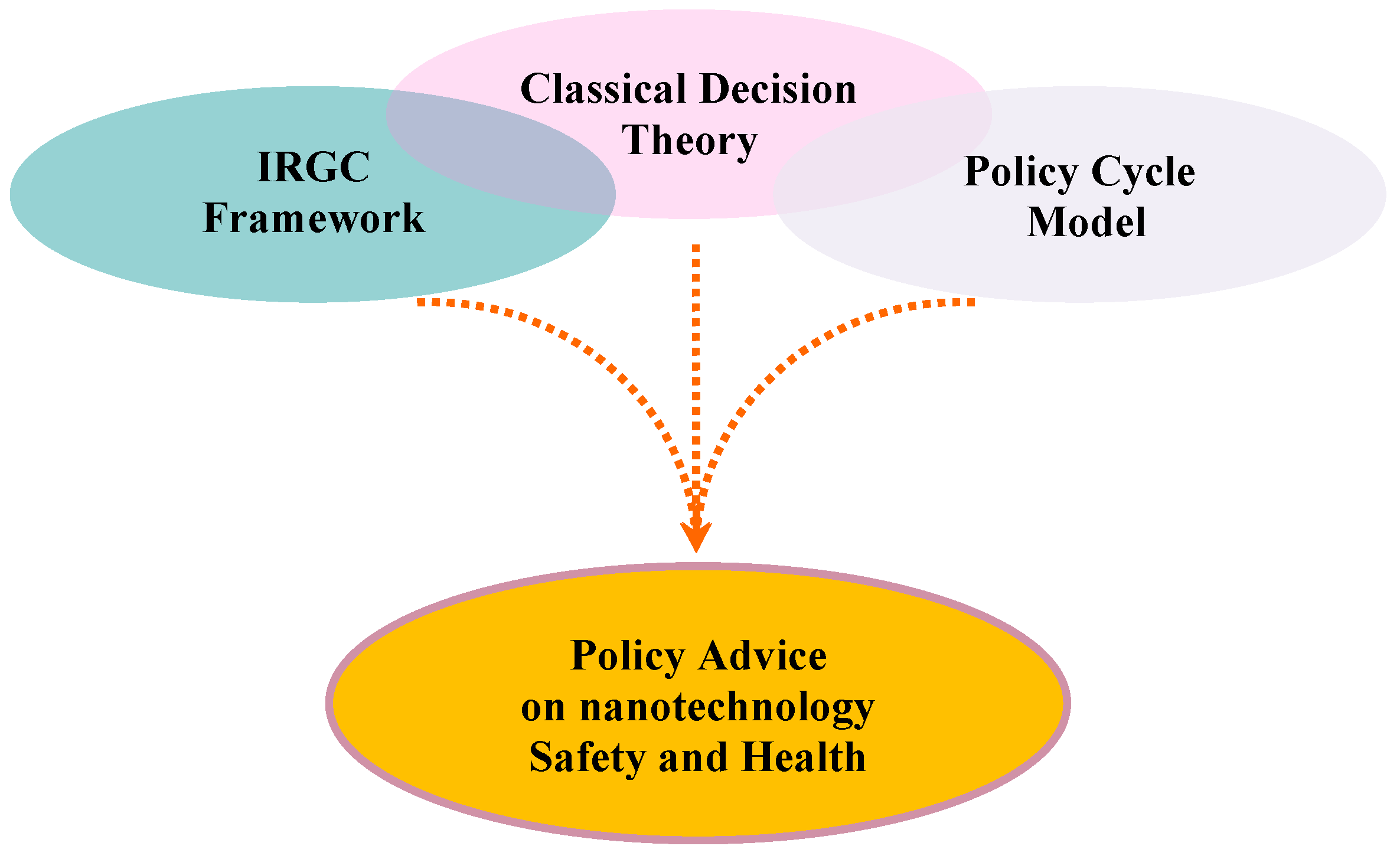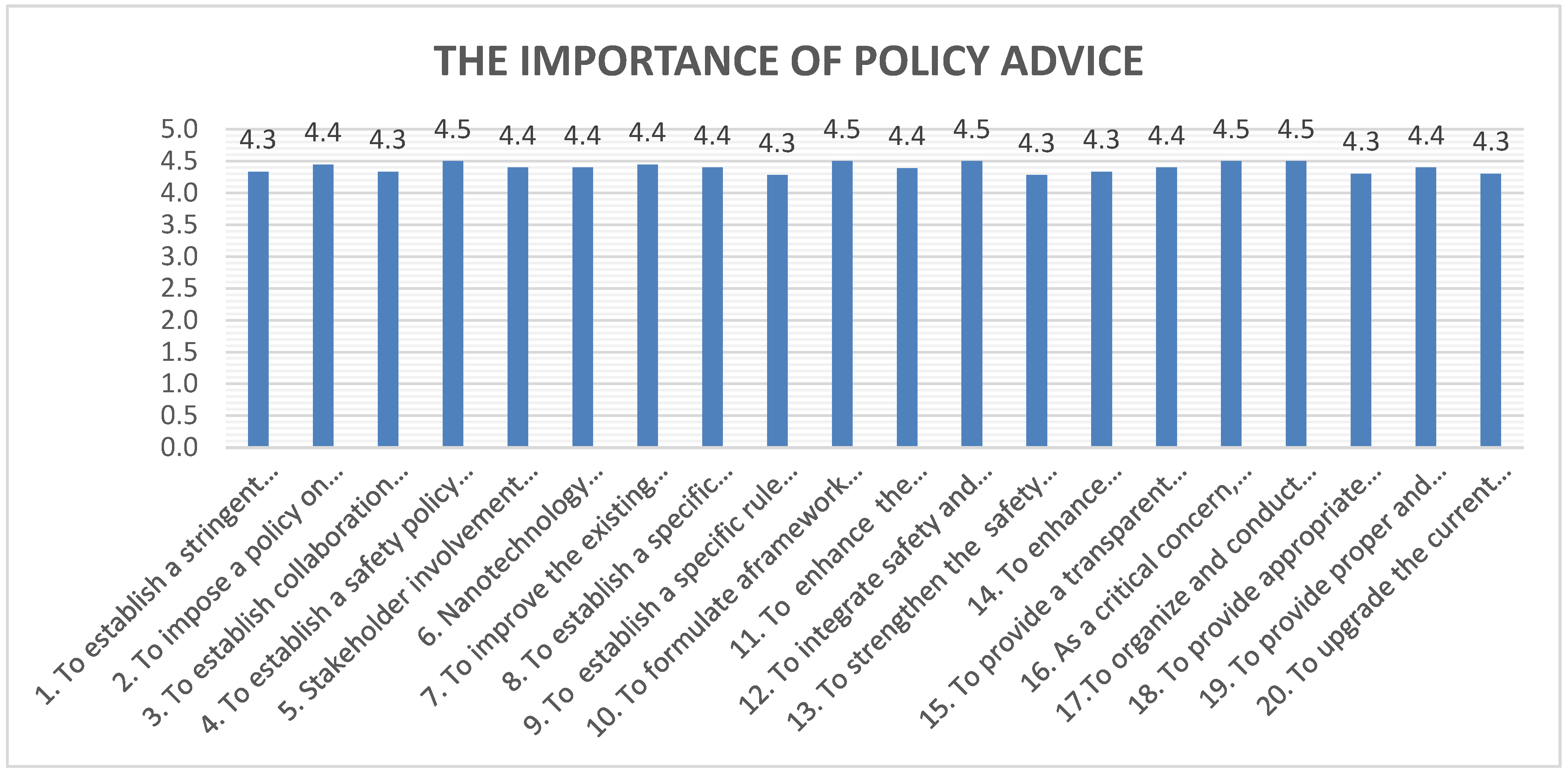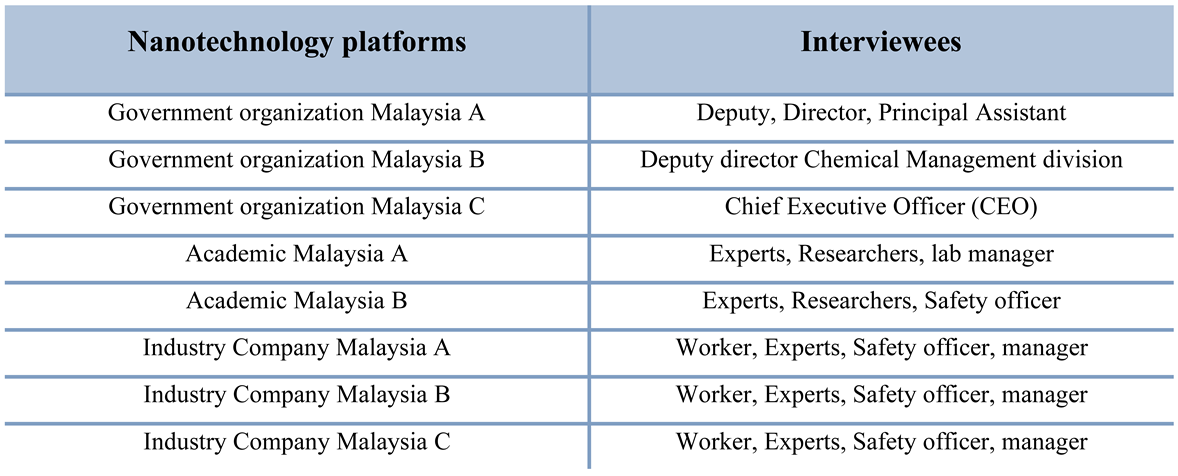Introduction
Nanotechnology is progressing rapidly in a variety of contemporary fields. Nanomaterials (NMs) are readily detectable in numerous industries, including the food, energy, electronics, cosmetics, and pharmaceutical sectors. NMs are particles with diameters ranging from 1 to 100 nm. Due to this, nanoparticles have physicochemical characteristics that set them apart from other chemical compounds (e.g., size, shape, and surface area) (Park and Yeo, 2016). For instance, due to their small size, they may possess unusual characteristics, such as being released into the workplace during production or use and thereby entering the worker's body through natural channels such as inhalation, ingestion, and dermal routes. Such events introduce new safety standards for NMs (Lebre et al., 2022). A quick search reveals a reasonably high volume of scientific articles on various aspects of nanotechnology produced by low- and middle-income countries. Despite this, far too little is known about the toxicity and safety of NMs and their accompanying risk evaluations (Boccuni et al., 2017). In Malaysia's eighth government plan (2005-2001), nanotechnology was identified as a subject of study, and the national organization's innovation council identified it in 2009 as a critical factor for the country to achieve advanced status by 2020 (Karim and Munir, 2015). In Malaysia, nanotechnology is a constantly increasing industry, striving for greater presence in the world market and a bright economic future inside the country, with 1,858 positions in the frontier levels, workers, and 8,855 administrative and indirect jobs anticipated to be created by 2025 (Ming, 2020). All of this indicates that Malaysia has a nanotechnology action plan for 2021-2030 that takes safety in the context of nanotechnology development and improving nanotechnology standards into consideration (Canton, 2021). The Occupational Safety and Health Act of 1994 (OSHA) in Malaysia established laws for the management regulatory framework for chemical materials in order to create safe and healthy working conditions. The Department of Occupational Safety and Health (DOSH) is afterwards responsible for implementing the regulations (Department of Occupational Safety and Health, 2005). DOSH published recommendations for the control and safe handling of nanoparticles in 2018; nonetheless, a complete plan is required to execute the various components of these regulations in nano workplaces. It should be noted that one of the benefits of having a dynamic policy is that it can function as a feed forward component for covering and updating the current DOSH guideline. Ismail et al. (2019) report that the majority of Malaysian nano platforms still lack clarity on the presentation of DOSH rules. This study also said that there is currently no risk assessment and management in nano workplaces, and possible threats are only analyzed from a broad perspective. This background highlights the urgent need for Malaysia to evaluate and comprehend the risks and hazards of exposure to nanomaterials in nano workplaces, as well as to evaluate and comprehend the current guidelines governing the risk assessment of nanotechnology. Consequently, the current study proposes policy guidance with the objective of facilitating the implementation of the DOSH nano safety guideline and enhancing it into a more dynamic and comprehensive nano safety policy.
Research Objective and Research question
Figure 1.
Research Objective and question. The schematic illustration depicted the research objective and question of the present research.
Figure 1.
Research Objective and question. The schematic illustration depicted the research objective and question of the present research.
Materials and Methods
This qualitative study examines the most recent NMs safety guidelines and procedures in order to meet the study's objective. In addition, it evaluates the current safety and health situation of nano workers and researchers in Malaysia's important nanotechnology platforms, such as government organizations, industries, and academic institutions. Qualitative techniques are employed in the analysis of complex and quantitatively observable phenomena study (Suri, 2011) (
Appendix A). Thematic analysis was utilized to analyze interview data (Boyatzis, 1998). For this study's qualitative methodology, authorities, researchers, and workers (n = 20) were interviewed in three sectors (with workforce sizes ranging from 20 to more than 100) using a well-developed and executed interview schedule. (
Table 1). It is essential to emphasize that the chosen academic institutions are currently key actors in nanotechnology research in Malaysia. Position, duration of involvement, and a minimum of three years of work experience with NMs were used to choose the participants. In addition, the Delphi technique was used in this study, which consisted of a series of progressive and repeated surveys to obtain a consensus among 15 experts from various organizations for validating policy proposals and taking into account both the facts and opinion of experts (see
Appendix B). The Delphi method belongs to the qualitative methodology area (Patton, 1990).
Research Framework
This study aims to contribute to the formulation of a comprehensive nanotechnology policy in Malaysia. The international risk governance council (IRGC) framework was used in this study to answer the research question and gain a better understanding of the current safety and health situation in Malaysian nano workplaces. This framework provides a structure and integrated method for making risk management decisions, analyzing challenges, and evaluating nanotechnology opportunities (Renn and Roco, 2006). In light of this, the current study examined all parts of the IRGC framework, including the three basic steps of pre-assessment, risk appraisal, and risk management. Additionally, tolerability and acceptability judgement, as well as communication, were studied as two additional parts since they connect knowledge translation to three crucial criteria (
Figure 2).
These elements are investigated within the framework of the IRGC: i) knowledge of DOSH guidelines, ii) health monitoring, iii) health risk knowledge, iv) safety and health audit procedure, v) health problems records and documentation, vi) availability of specified PPE for NMs, vii) training courses, viii) ventilation systems, ix) NMs disposal, x) risk evaluation from an acceptable or tolerable perspective, and xi) decision making for regulating NMs.
In addition, Neumann and Morgenstern's (1950) classical theory of decision-making was utilized in this study. This theory is applicable to the current investigation since it emphasizes the decision-making process in an unpredictable situation, such as NM's risks. Risk is described as an uncertainty in the IRGC framework. This theory is simple to grasp and includes simple procedures such as problem identification and recognition, followed by problem resolution, testing and investigation of elements, decision making, and implementation (Tarter and Hoy, 1998). Further, the policy cycle model developed by Lasswell (1956) was utilized in the present study to aid in the formulation of a comprehensive policy. The policy process, includes problem identification, agenda setting, policy development and formulation, policy implementation, and policy evaluation. After understanding the problem and applying the decision process in accordance with classical decision theory, the policy cycle is the optimal method to help, construct, and develop policy based on our decision. In other words, decision-making is essential to the larger policy process. This study focuses on agenda setting, a stage in the paradigm of the policy cycle. Agenda-setting, policy formation, and policy development have an impact on the delivery of effective policy (Tonn and Peretz, 1998). The integration of the IRGC framework, classical decision-making theory and policy cycle model into the conceptual framework of the present research study guide this research to reach its objective (
Figure 3).
Results
The analysis of collected data suggested that the general understanding or grasp of health monitoring among workers should be a top priority on the road towards development of nanotechnology in Malaysia.
One of the goals of this study was to determine whether there are documented cases of NM-caused health concerns for the nano workers. The vast majority of respondents expressed their favor for thorough health monitoring and related examinations. In the analyzed micro workplaces, the current health monitoring procedure remains vague and unrecognized. There is no evidence in any of the nano workplaces that employees' health complications are monitored in relation to their working conditions. Ismail and his colleagues revealed in their 2019 research that there are no health and accident reports for nano workers, which supported their conclusions (Ismail et al., 2019). In the same vein, the importance of medical monitoring should be emphasized because it is one of the most effective methods for assessing health threats and dangers in the workplace. Globally, medical comprehension of NM-caused health concerns is an active and rapidly expanding research subject. In this regard, Hemmendinger et al. (2020) and Iavicoli et al. (2017) emphasized the importance of health surveillance in nano workplaces to protect nano employees. In Malaysia, there is no routine for primary examinations and subsequent treatment processes for workers of nanotechnology platforms, such as manufacturers and research facilities, and only their safety equipment is supervised and audited (e.g., fire extinguisher, ventilation system). Auditing health and safety notices is generally part of an employer's obligation to employees.
Another outcome of present study is that specialized medical exams and health monitoring are inadequate and must be defined and organized. In addition, examining the health process is crucial for identifying the present threats to the health of nano workers. Consequently, it is essential to outline auditing health processes in detail.
This study also examined the existing state of health risk assessment and management for NMs in Malaysia. According to the interviews, numerous organizations have implemented programmes to educate employees about occupational dangers and the negative impacts of working with hazardous substances. Surprisingly, none of these programmes addressed the safe handling and labouring with NMs as well as how to assess and report health risk issues. Similar to these findings, Ismail et al. (2019) and Takeuchi et al. (2014) emphasized the importance of specifying such regulations for the protection of nano workers, since they found that generic chemical risk management was the standard practice. A dearth of specific risk management suggestions for NMs in the workplace was also observed.
In addition, worker interviews have showed that the most recent DOSH safety and health standard is still a foreign concept. Ismail et al. (2019) describe comparable outcomes and a lack of clarity in DOSH guideline content, which is consistent with our observation.
In order to develop a workable strategy for DOSH guidelines, the current study provides particular training courses for the safe handling of nanomaterials in Malaysian workplaces. In addition, creating opportunities for direct communication between nano workers and responsible parties via authorities with specialized training would bring DOSH guideline implementation in Malaysia one step closer to completion. Furthermore, to lessen health issues related with the nature of NMs, the use of personal protective equipment (PPE) in the workplace while improving worker safety can reduce worker exposure and provide a healthier environment. According to a 2017 WHO report, the use of personal protective equipment (PPE) is the first step in protecting nano workers (official WHO website, 2017). During interviews with nano workers, it became clear that there is a lack of in-depth knowledge regarding the dangerous and negative health impacts of nanomaterials. It may cause individuals to disregard the use of PPE.
Another focus area in this research was to assess need of define and development of the specified protocol, also specified safety data sheets to protect nano workers. Findings demonstrated that to this very day, the general chemical data sheet is the only resource that any responsible manager would turn to. The main idea is that NMs are likewise other tailored chemical products, and therefore, they should be classified under the protection regulations which defined for other chemicals.
Identifying the presence of a standard ventilation system is another essential element when working with NMs. Most interviewees outlined that the infrastructure of nano workplaces lacked local ventilation systems. Besides, these findings indicated that most of the respondents' information about appropriate ventilation systems for nano workplaces is inadequate. According to the national institute of occupational safety and health (NOISH) (2014), the effectiveness of ventilation systems and the ability to attract and capture NMs must be examined in order to be adequate for lowering their volume and distribution in nano workplaces. It is previously reported that (Peixe et al., 2015) employment of local ventilation systems can reduce hazard exposure of the nano workers by using high-efficiency particulate air filters that are able effectually to eliminate NMs.
In the context of disposal of NMs waste, findings of this study show this issue is another crucial factor which should be taken into consideration for progress in future strategy. The results indicate that there is no clear protocol for the disposal of NMs waste in the studied workplaces. There was a pervasive dearth of knowledge regarding the proper disposal of NMs waste. This enhancement also entails instituting safety procedures to restrict workers' exposure to hazards. Notably, this measure will have an effect on Malaysia's natural ecology and preserve the country's environmental resources for future generations.
And last but not least, we found that communication and collaboration between nanotechnology platforms should be strengthened for improved DOSH safety guideline implementation. In order to assist decision making, the findings from interviews with influential managers and authorities indicate a need for increased engagement and communication at the upper levels of nano organizations.
The findings of present study demonstrated that nano workplaces in Malaysia are not adequately safe and secure for working with nanomaterials (NMs) and require top-down monitoring procedures and precautionary principal considerations, such as improved dialogue and communication between nanotechnology platforms, in order to implement and coordinate DOSH NMs safety guidelines. Therefore, in line with these findings following policy advice are presented.
Nanotechnology Policy Advice in Malaysia
This investigation focused on worker health and safety in nanotechnology workplaces. This sector is crucial to Malaysia's long-term nanotechnology growth objectives. Several improvement areas were identified by the findings of this investigation. According to the findings, several strategic inadequacies in the analyzed workplaces should be addressed. The presentation and implementation of a comprehensive DOSH policy safety guideline for NMs requires collaboration and communication between policymakers, administrative officers, stockholders, and research laboratories. This strategy reinforces its practical aspects and fosters the growth of a safety culture in nanotechnology-related environments. As a result, this study provides a summary of the significant findings in the studied platforms as well as suggestions for the establishment of a dynamic DOSH safety and health policy guideline.
Table 2.
Policy advice and suggestions. The key findings in the investigated platforms presented as following advice and suggestions to assist developing a dynamic DOSH safety and health policy guideline.
Table 2.
Policy advice and suggestions. The key findings in the investigated platforms presented as following advice and suggestions to assist developing a dynamic DOSH safety and health policy guideline.
To further validate this proposed policy advice, the Delphi technique was utilized, which is a quantitative survey to establish the level of consensus among nanotechnology industry professionals regarding the proposed policy advice. To support the study's conclusions and pertinent parts, a survey was distributed to fifteen nano-related specialists. The mean score on a scale from 0 to 5 ranges from strong disagreement to strong agreement. As seen in
Figure 4, the majority of respondents emphasized the significance of this policy proposal's components.
Discussion
Using the IRGC framework as the primary architecture, the present research has effectively outlined some of the basic stages required for establishing a realistic policy advice for nanotechnology current safety guidelines in both industrial and academic platforms in Malaysia. Through this research, some of the primary risk contexts involved in working with NMs in different phases of the IRGC framework have been investigated, e.g., pre-assessment, risk appraisal, the judgment of tolerability and acceptability risk, risk management, decision making, and communication. To establish a basis for future comprehensive safety and health policy guidelines in Malaysia, it is necessary to identify present gaps in each of the subsections belonging to the primary risk scenarios shown in the IRGC framework.
The outcomes of this study indicated that adopting the IRGC framework may be of great assistance in identifying numerous elements of today's difficulties in depth. It is not unexpected that a detailed assessment of existing understanding, knowledge and health risk of NMs is required prior to the provision of a possible policy advice.
However, deciding where and how to begin such fundamental action may be a difficult task. Hence, this research chose IRGC as a framework with already proven effectiveness for evaluating and assessing safety and health risk of workers, to be employed for exploring present issues related to the working with NMs in both research laboratories and industrial manufacturers in Malaysia. Several earlier studies have emphasized the need of risk management and risk assessment for safe handling and dealing with NMs.
Recruitment of professional experts for medical exams, health monitoring, and audit procedures is a crucial missing step which led to accurate health information and documentation, generate reliable health evaluation and management, and enhance the effectiveness of future programmes. This emphasizes the significance of implementing a transparent and verifiable management system in nano workplaces in order to conduct a straightforward safety and health audit. The gathered information showed today there is a lack of communication between different involved authorities and, with the nano workplaces about the nanotechnology recent safety guidelines.
Also, it is not clear how performance of DOSH guideline is supposed to be assessed and evaluated by different responsible parties. Hence, this study emphasis that filling the communication gaps between different role players involved in nanotechnology development in Malaysia is a critical step for defining a policy to make a practical sense for today’s DOSH safety guideline. This study showed there is no health monitoring and audit health and safety for working with NMs in the industry workplaces under existing nanotechnology standards in Malaysia.
In the absence of rules governing nanotechnology risk assessment and management, it is impossible to evaluate and judge the dangers posed by NMs in nano workplaces as acceptable or tolerable. DOSH has already provided numerical guidelines for managing risks linked with NM exposure and handling. Recent studies, however, indicate that the implementation of these restrictions must yet be determined.
Research Contribution
The contribution of this research is grounded in following the theory and body of knowledge in some of the Malaysian nanotechnology workplaces, and both industry and academic platforms. Also, has contributed to methodology, and to the practice of the nanotechnology industry. The contribution of body, knowledge is explained in the context of theory building and knowledge development to propose recommendations for future policy for DOSH's present guideline to improve safety and health issues that Malaysian nano workers are facing today.
The current research adopted the integration of the IRGC framework, classical decision-making theory, and the policy cycle model in order to investigate and comprehend the critical elements of safety and health in nano-manufacturing and safe handling and thus able to provide some policy advice. The integration of the IRGC framework as a novel approach to recognizing existing possibilities and identifying deficiencies in Malaysian nanotechnology with classical decision-making theory produces a primary structure network capable of integrating and identifying the problem, diagnosing the obstacles, identifying alternative approaches, examining the consequences, making a decision, and implementing the decision in a nanotechnology environment. Nonetheless, decision-makers almost never have access to all pertinent data, nor can they generate all conceivable alternatives and accurately foresee all potential consequences (Feldman and Kanter, 1965). Traditional decision-making theory concludes with the implementation of the final choice. After executing a choice using standard decision theory, the policy process cycle provides the best opportunity for evaluation. Particularly, decision-making can address the policy formulation phase of the policy process cycle to a greater extent. In this study, agenda-setting is regarded as a component of the policy cycle process, which follows problem identification. The technique for establishing the agenda then fosters the development of new policy challenges. Consequently, by categorizing the various steps of this process, we can enhance our understanding of the safety and health risks in nano workplaces. In addition, this study extends previous research based on the classical theory of decision-making by examining and validating key components of IRGC in nanotechnology platforms. Specifically, our findings validate the fundamental role of identifying the problem, diagnosing the problem, defining an alternative, examining the consequences, making a decision, and implementing the decision in order to improve the safety and health of workers in a nanotechnology environment. This research proposes a few sub-elements to further clarify the IRGC Framework's key elements.
The research includes a triangulation strategy involving document analysis and interviews. Studying in academic nanotechnology workplaces provides the opportunity to observe and comprehend the existing safety situation and guidelines for researchers, as well as safety in academic nanotechnology workplaces. It provides the opportunity to connect with nanotechnology researchers, specialists, safety officers, and managers who can supply accurate information and are acquainted with the job issues. This technique was an effective introduction to the next step, which consisted of meeting with industry stockholders, specialists, and workers. It was demonstrated that triangulating data through document analysis and semi-interviews were effective methods for gathering information on the existing safety condition of nanotechnology employees in Malaysian industry and academia. The sampling of this research involves workers, researchers, experts, and key decision-makers. However, the implication of the resource-based framework, which involve “bottom up” synergies, motivated the research to include various levels of individuals in data collection, to provide a more holistic point of view. Thus, the IRGC framework created an appropriate paradigm for overall inclusiveness in the research sampling. Personal contact was one of the most critical factors that may encourage industry experts to participate in an interview, while frequent follow-up emails and phone calls could help enhance the response rate.
The safety perspective of nanotechnology should include good practices and development safety guideline. Nowadays, with the increase of engineered NMs, there may be undesirable health risks that lead to concerns about the safety, consumption, and disposal of NMs released into the environment. However, nano safety considerations in the nanotechnology workplaces lag after technological developments which is due to the lack of proper communication between different involved sectors such as administrative, shareholders and working platforms. Through this research, the safety and health DOSH guideline implementation in nanotechnology platforms was investigated to empower understanding of the need for a supportive regulation and enhance forward-looking for defining a policy guideline in future. It is also noteworthy, that the findings of current research have the potential to be extended to developing the future. It is also noteworthy, that the findings of current research have the potential to be extended to developing the future safety culture in nanotechnology industries and research laboratories in academia. The recorded responses from academic workers as well as manufacturers are valuable indications of demand for detailed nanotechnology safety and health policy guideline in Malaysia. The practice of safety culture and performances subsequently will be improved, if future policy and regulation for the current DOSH guideline become equipped with precise safety and risk management procedures. Furthermore, the involvement of nanotechnology governing agencies in defining safety and risk management protocols will create more effective reinforcement towards establishing comprehensive policy for today’s DOSH nanotechnology safety and health guideline. These findings also indicated that the DOSH guideline on the safe handling of NMs would transform to a more advanced structure once a comprehensive nanotechnology safety and health policy are defined.
Conclusions
Utilizing the IRGC framework, this study investigated some of the most important safety and health factors in two separate nanotechnology workplaces in Malaysia. Thus, this study described some of the most pressing difficulties and questioned the existing safety and health risk scenario in order to provide valuable recommendations for the future policy governing the current DOSH nanotechnology guideline in Malaysia. In this section, it is essential to note that some of these discoveries should be prioritized as concerns to be investigated in the initial phases of future study. Adopting the IRGC framework for categorizing concerns and collecting data in current research afforded the advantage of structuring the study's infrastructure on several essential pillars, including pre-assessment, risk evaluation, risk management, decision making, tolerable and acceptance risk judgement, and communication. Each of these domains contributes to our understanding of the aspects listed below. Consequently, this study contributed new knowledge to the exploration of current neglected elements in the health and safety risk issues in nanotechnology platforms in Malaysia and proposed principal recommendations for constructing a feasible policy guideline that will enhance the current safety guideline and present a comprehensive policy. In terms of procedures, systematic research is also undertaken using qualitative methodology. Current study magnified existing problems and neglected issues ahead of implementing of DOSH health and safety guideline in Malaysia. Therefore, by offering some of the practical and yet articulated proposals for commencing the creation of policy for DOSH's current guideline, we have arrived at a conclusion. In addition, policy development entities must consider all aspects of policy formulation. In addition, by integrating the policy recommendations given in this study with the Nanotechnology Action Plan 2030, a dynamic and comprehensive future nanotechnology policy guideline can be established in Malaysia. To develop a sustainable nanotechnology environment in Malaysian industrial workplaces and research facilities, workers at all levels, stakeholders and accountable authorities, and government managers must comprehend the health and safety elements for protecting workers. Consequently, a noteworthy strength of the current study is that, by using the IRGC framework, it united all these distinct parts into a network and collected data that highlighted missing areas and poorly understood issues that require additional investigation. Along with the rapid development of nanotechnology in Malaysia and the country's potential economic growth, this study emphasized the importance of communications between different sections in order to bridge the current gaps in a more timely manner. This research paved the way for future researchers to produce DOSH health and safety guidelines in a more methodical and coordinated manner.
Author Contributions
Supervision, A.M.M.; Writing—original draft, M.E.; Validation, A.M.M.; Consulting & Editing, N.M.N. All authors have read and agreed to the published version of the manuscript.
Funding
This research received no external funding.
Informed Consent Statement
Informed consent was obtained from all subjects involved in the study.
Data Availability Statement
Respect to confidentiality, data is not publicly available.
Conflicts of Interest
The authors of this study, hereby, express that they have no conflict of interest.
Appendix A
Interview Outcome
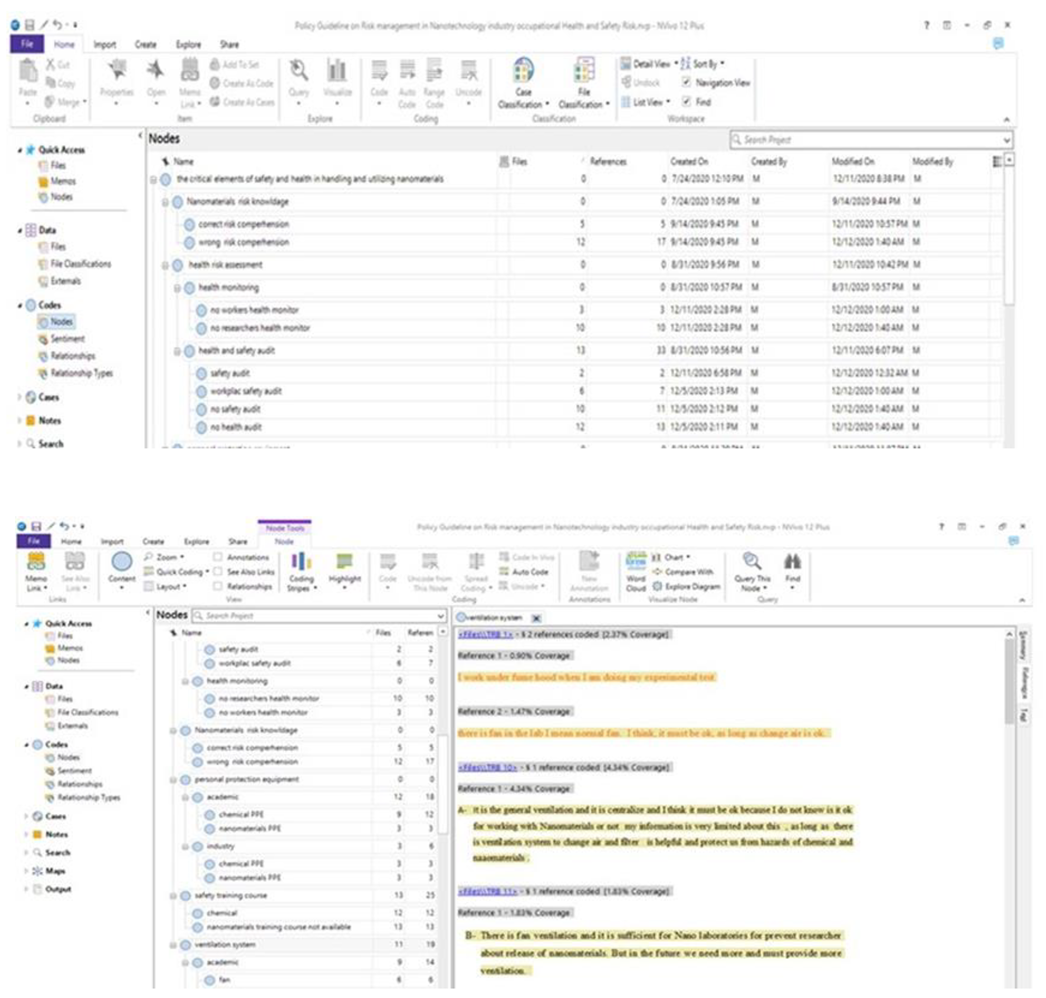
Appendix B
To what extent do you agree with the policy advice?
References
- Park, H. G., and Yeo, M.-K. (2016). Nanomaterial regulatory policy for human health and environment. Molecular and Cellular Toxicology, 12(3), 223-236. [CrossRef]
- Lebre, F., Chatterjee, N., Costa, S., Fernández-de-Gortari, E., Lopes, C., Meneses, J., & Alfaro-Moreno, E. (2022). Nanosafety: An Evolving Concept to Bring the Safest Possible Nanomaterials to Society and Environment. Nanomaterials, 12(11), 1810. [CrossRef]
- Boccuni, F., Gagliardi, D., Ferrante, R., Rondinone, B. M., & Iavicoli, S. (2017). Measurement techniques of exposure to nanomaterials in the workplace for low-and medium-income countries: A systematic review. International journal of hygiene and environmental health, 220(7), 1089-1097. [CrossRef]
- Karim, M. E., Munir, A. B., Reza, A. W., Muhammad-Sukki, F., Yasin, S. H. M., AbuBakar, S. H., and Rahim, R. A. (2015). Too enthusiastic to care for safety: Present status and recent developments of nanosafety in ASEAN countries. Technological forecasting and social change, 92, 168-181. [CrossRef]
- Ming, L. S. (2020). Scaling up Opportunities in the Nanotechnology Sphere in Penang.
- Canton, H. (2021). Organisation for Economic Co-Operation and Development—OECD. In The Europa Directory of International Organizations 2021 (pp. 677-687).
- Department of Occupational Safety and Health (2005), Guidelines on occupational health services. Ministry of Human Resources Malaysia.
- Ismail, S., Budin, S., and Ali, S. A. M. (2019). The nanotechnology application and workforce health and safety a study of the Malaysia laws, statutory regulations and guidelines on nanotechnology. In Journal of Physics: Conference Series, 1349(012031).
- Suri, H. (2011). Purposeful sampling in qualitative research synthesis. Qualitative research journal. [CrossRef]
- Boyatzis, R. E. (1998). Transforming qualitative information: Thematic analysis and code development.
- Patton, M. Q. (1990). Qualitative evaluation and research methods.
- Renn, O., and Roco, M. C. (2006). Nanotechnology and the need for risk governance. Journal of Nanoparticle Research, 8(2), 153-191. [CrossRef]
- Graboś, R. (2004). Qualitative model of decision making. In International Conference on Artificial Intelligence: Methodology, Systems, and Applications. 480-489.
- Von Neumann, J., and Morgenstern, O. (1950). Theory of Games and Economic Behavior, Alchian, “Uncertainty, Evolution, and Economic Theory”, 58(3), 211-221.
- Tarter, C. J., and Hoy, W. K. (1998). Toward a contingency theory of decision making. Journal of educational administration, 36(3), 212-228. [CrossRef]
- Lasswell, H. D. (1956). The decision process: Seven categories of functional analysis.
- Tonn, B., and Peretz, J. (1998). Institutional issues and subnational environmental decision making.
- Feldman, J., and Kanter, H.E. (1965), “Organizational decision making”, in March.The Handbook of Organizations.614-49.
- Hemmendinger, M., Wild, P., Shoman, Y., Graille, M., Bergamaschi, E., Hopf, N.,and Canu, I. G. (2020). Reference ranges of oxidative stress biomarkers selected for non-invasive biological surveillance of nanotechnology workers: Study protocol and meta-analysis results for 8-OHdG in exhaled breath condensate.327, 41-47. [CrossRef]
- Iavicoli, I., Leso, V., Beezhold, D. H., and Shvedova, A. A. (2017). Nanotechnology in agriculture: Opportunities, toxicological implications, and occupational risks.329, 96-111. [CrossRef]
- Takeuchi, M. T., Kojima, M., and Luetzow, M. (2014). State of the art on the initiatives and activities relevant to risk assessment and risk management of nanotechnologies in the food and agriculture sectors. 976-981. [CrossRef]
- World Health Organization (2017). WHO Guidelines on Protecting Workers from Potential Risks of Manufactured Nanomaterials; World Health Organization: Geneva, Switzerland.www.osha.gov/Publications/OSHA_FS-3634.
- National Institute for Occupational Safety and Health (2014). Current Strategies for Engineering Controls in Nanomaterial Production and Downstream Handling Processes, US Department of Health and Human Services (DHHS), Centers for Disease Control and Prevention, Cincinnati. DHHS (NIOSH). 2014–2102.
- Peixe, T. S., de Souza Nascimento, E., Schofield, K. L., Arcuri, A. S., & Bulcão, R. P. (2015). Nano toxicology and exposure in the occupational setting. Occupational Diseases and Environmental Medicine, 3(03), 35.
- Feldman, J., and Kanter, H.E. (1965), “Organizational decision making”, in March.The Handbook of Organizations, Rand McNally and Co. 614-49.
|
Disclaimer/Publisher’s Note: The statements, opinions and data contained in all publications are solely those of the individual author(s) and contributor(s) and not of MDPI and/or the editor(s). MDPI and/or the editor(s) disclaim responsibility for any injury to people or property resulting from any ideas, methods, instructions or products referred to in the content. |
© 2023 by the authors. Licensee MDPI, Basel, Switzerland. This article is an open access article distributed under the terms and conditions of the Creative Commons Attribution (CC BY) license (http://creativecommons.org/licenses/by/4.0/).


